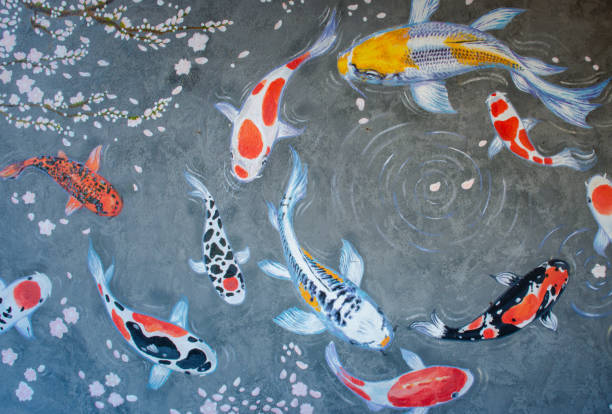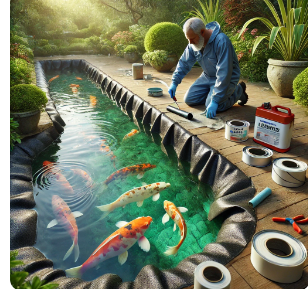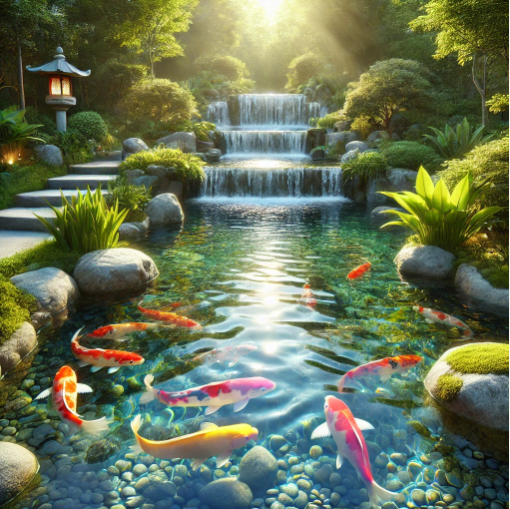When it comes to koi fish, three of the most recognized and highly valued varieties are Showa, Kohaku, and Sanke. These koi belong to the Gosanke group, which consists of the most prestigious koi fish in the world. While they may share some similarities, they have distinct differences in their colors, patterns, and breeding standards.
If you’re new to koi keeping or want to understand the differences between these three legendary koi, this guide will help you distinguish Showa, Kohaku, and Sanke koi with confidence.
1. The Basics of Gosanke Koi
The term Gosanke refers to the three main koi varieties that are often seen in koi competitions:
- Kohaku (Red & White Koi)
- Taisho Sanke (Red, White & Black Koi)
- Showa Sanshoku (Black, Red & White Koi)
Each variety has its own unique characteristics, and understanding these differences will help you choose the best koi for your pond.
2. Kohaku Koi: The Classic Red & White Beauty
A. What is a Kohaku Koi?
Kohaku is considered the foundation of all koi varieties. It has a white body (Shiroji) with red markings (Hi). This variety is one of the oldest and most beloved koi types.
B. Key Features of Kohaku Koi
✔ Base Color: Pure white
✔ Markings: Red patches (Hi) on the body
✔ No Black (Sumi) markings
✔ Ideal Pattern: Symmetrical, balanced red markings
C. Symbolism of Kohaku Koi
Kohaku represents purity and good fortune. It’s a koi that is often recommended for beginners and experienced hobbyists alike.
D. Variations of Kohaku Koi
- Straight-Pattern Kohaku – Red markings run down the center of the body
- Maruten Kohaku – A separate red patch on the head (similar to Tancho)
- Inazuma Kohaku – A lightning bolt-shaped red pattern
E. How to Identify a High-Quality Kohaku
- Deep, uniform red color
- Bright, snow-white base
- Crisp and well-defined edges between red and white
- No black markings or imperfections
3. Taisho Sanke: The Elegant Red, White & Black Koi
A. What is a Sanke Koi?
Taisho Sanke (often called Sanke) is similar to Kohaku but includes black markings (Sumi) on top of the red and white base.
B. Key Features of Sanke Koi
✔ Base Color: White with red patches
✔ Black (Sumi) Markings: Small and delicate, appearing on the back and body
✔ No Black on the Head – Unlike Showa koi
✔ Ideal Pattern: Well-distributed red, black, and white
C. Symbolism of Sanke Koi
Sanke koi represent strength, balance, and longevity. Their striking patterns make them one of the most sought-after koi varieties.
D. Variations of Sanke Koi
- Maruten Sanke – A red “crown” on the head, similar to Tancho
- Doitsu Sanke – A scaleless version of Sanke
- Tsubo-Sumi Sanke – The black markings appear only on the white parts
E. How to Identify a High-Quality Sanke
- Bright white base with rich red markings
- Small, refined black (Sumi) spots placed on the body (not the head)
- Balanced and symmetrical patterning
- Clean, unblemished fins
🔹 Pro Tip: The best Sanke koi have small, elegant black spots instead of large black patches.
4. Showa Koi: The Bold & Powerful Black Koi
A. What is a Showa Koi?
Showa Sanshoku (Showa) is a black-based koi with red and white markings. Unlike Sanke, Showa has black patterns that extend onto the head.
B. Key Features of Showa Koi
✔ Base Color: Black (Sumi) with red and white markings
✔ Black on the Head & Body
✔ Deeper, more intense black than Sanke
✔ Ideal Pattern: Balanced red, white, and black across the body
C. Symbolism of Showa Koi
Showa koi represent endurance and power. They have a bold and striking appearance compared to Kohaku and Sanke.
D. Variations of Showa Koi
- Kindai Showa – More white and red with less black
- Doitsu Showa – Scaleless version of Showa
- Hi Showa – More red with minimal white
E. How to Identify a High-Quality Showa
- Strong black (Sumi) base that wraps around the body
- Deep red markings (Hi) and clear white patches
- Well-balanced colors across the fish
- Black on the head (unlike Sanke)
🔹 Pro Tip: A high-quality Showa has deep black markings, balanced with strong red and white patches.
5. Showa vs. Kohaku vs. Sanke: Key Differences
| Feature | Kohaku | Sanke | Showa |
| Base Color | White | White | Black |
| Red (Hi) Markings | Yes | Yes | Yes |
| Black (Sumi) Markings | No | Yes (on body, not head) | Yes (on body & head) |
| Best Pattern | Balanced red patches | White-dominant with delicate black spots | Bold black base with red & white |
| Ideal for Beginners? | Yes | Yes | No (requires more care) |
🔹 Quick Identification Tip:
- If it’s just red & white → It’s a Kohaku
- If it has small black spots on the body (not head) → It’s a Sanke
- If it has black, red, and white (including black on the head) → It’s a Showa
6. Which Koi is Right for You?
- Kohaku is great for beginners due to its simple beauty.
- Sanke is a step up from Kohaku, offering extra contrast with black markings.
- Showa is the most dramatic, ideal for koi keepers who love bold, high-contrast fish.
If you want a traditional and elegant koi, go with Kohaku or Sanke. If you prefer a striking and powerful look, then Showa is the best choice.
Final Thoughts
Showa, Kohaku, and Sanke koi are three of the most prestigious and beautiful koi varieties. While they share similarities, their patterns, colors, and base tones make each one unique.
Key Takeaways:
✔ Kohaku is a classic red and white koi with no black markings.
✔ Sanke is a white-based koi with red and small black markings.
✔ Showa is a black-based koi with bold red and white patterns.
✔ Showa has black on the head, while Sanke does not.
✔ Kohaku is the easiest to identify and care for.
By understanding the differences between these three koi, you can choose the perfect fish for your pond and appreciate their beauty even more! 🐠✨
📌 Which koi variety do you prefer? Let us know in the comments!




